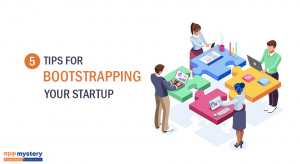Innovation Costs Money
One of the main drivers of innovation in our classic business market is funding. To innovate costs money, and so obviously, that money and where that money goes drives who gets to innovate and even how much. As we shift into a modern business market, we’ve witnessed a lot of change and one of those changes is something I like to call resourceful innovation; that is to innovate by relying on resources rather or more so than external funding aka bootstrapping.
According to start-up researcher Abdo Riani, most startups cannot afford to innovate because innovation is a long-term investment, and for self-funded startups, where short term results are key to the survival of the company, long term investments are rarely an option. When you also consider the fact that bootstrapped startups have to compete with funded rivals, it’s easy to see the pattern in which funding affects growth potential and prohibits innovation.
Bootstrapping Your Way to Innovation
Despite the limitations and constraints, many startups have managed to build highly successful and innovative companies without outside funding. As I mentioned earlier, we are seeing the market shift from a ‘by-the-book’, pay-to-play conglomerate, to an open world full of possibilities. This leaves the question of how to innovate open-ended, as we see more and more growth without outside funding. Abdo discussed some of the modern ways to bootstrap your way to innovation, and here they are:
5 Bootstrapping Techniques That Enable Founders To Initiate, Innovate And Grow Under Limited Resources.

Pre-sell products: The best way to put a value on ideas is through pre-selling. Remember, you must show that “the dog will eat the dog food” and the only way to do that is by gaining market traction. Our core A/B product strategy of getting products selling on Amazon and building market proof with sales is a great way to beta test, avoid total failures, and keep some money in the bank.
-
Leverage your network: Social capital is invaluable for startups, especially bootstrapped ones. A founders network can provide access, guidance, partnership opportunities, and even customers.
-
Maintain a stream of income: Investors want to see you totally committed to your business, but maintaining a stream of income gives bootstrapped entrepreneurs a plan B if certain conditions are not met: product failing to meet user needs, products don’t sell, patents rejected, etc. Even more than that, a stream of income prevents you from being overloaded with stress, which will drive you to make poor decisions, snap judgments, and desperate deals.
-
Don’t be afraid to negotiate: If you need terms that are specific to your business, work to customize supplier contracts. If you don’t ask, you don’t know. This is one of the things that separates an entrepreneur from someone with an idea. If you can’t speak up for the needs of your business, you’re going to have a hard time surviving.
-
Hazzard Rules of Hiring: While family and friends may be willing and eager to help out, amateurs sometimes (a lot) end up costing companies much more in both costly delays of time and money in re-dos in the long run, than if you just brought in an expert. There are certain times it is okay to rely on low cost labor, and there are times you really shouldn’t.
Now Get Out There And Innovate
There is ample room for venture initiation and product innovation under limited resources. In other words, you can bootstrap your way to innovation, but there’s something very important you must remember… You don’t only need to innovate, you need to out-innovate. You need to be one step ahead of yourself, and then 5 steps ahead of your competition. The job of an entrepreneur is never done, but if you can handle it, the payout is definitely worth the effort.
